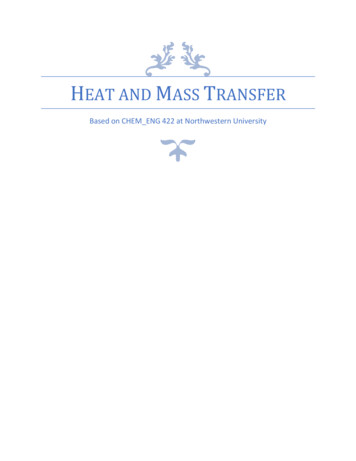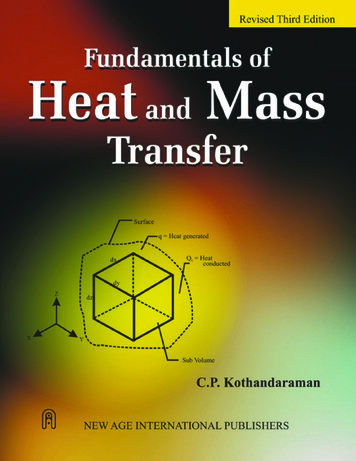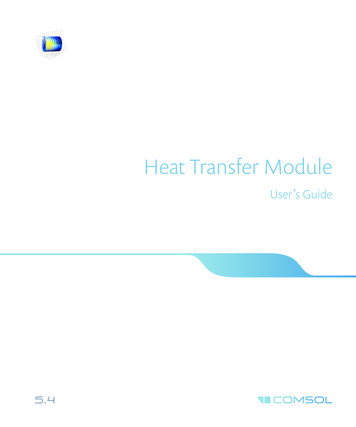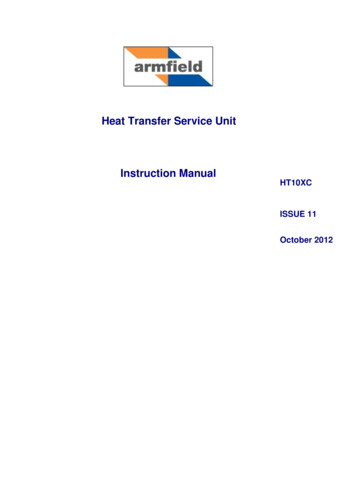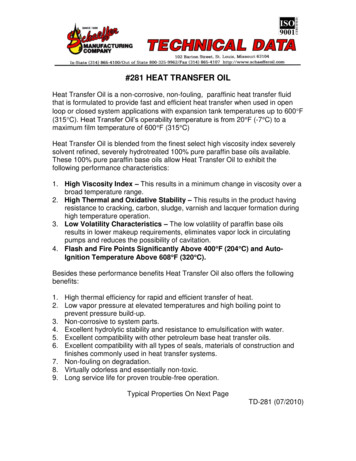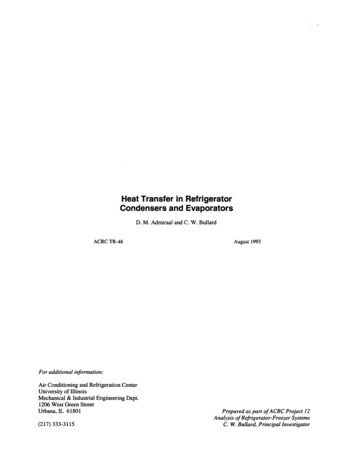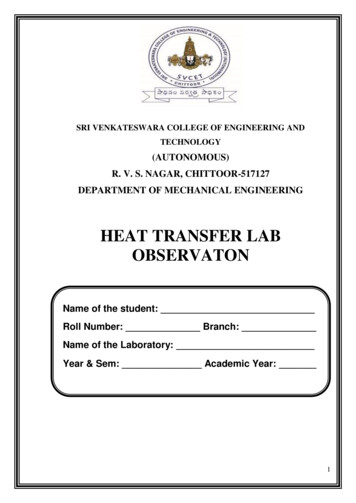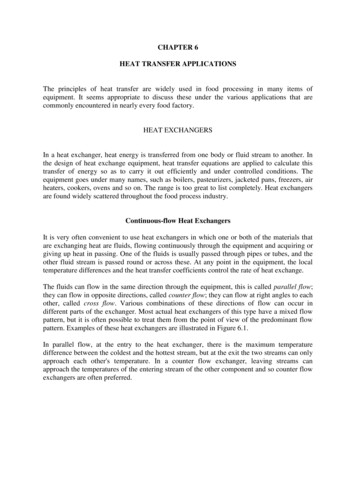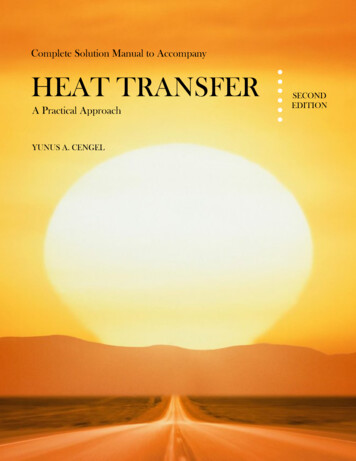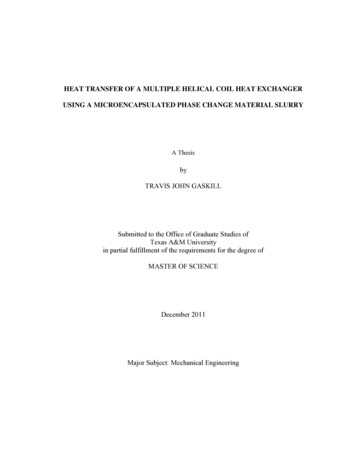
Transcription
HEAT TRANSFER OF A MULTIPLE HELICAL COIL HEAT EXCHANGERUSING A MICROENCAPSULATED PHASE CHANGE MATERIAL SLURRYA ThesisbyTRAVIS JOHN GASKILLSubmitted to the Office of Graduate Studies ofTexas A&M Universityin partial fulfillment of the requirements for the degree ofMASTER OF SCIENCEDecember 2011Major Subject: Mechanical Engineering
Heat Transfer of a Multiple Helical Coil Heat Exchanger Using a MicroencapsulatedPhase Change Material SlurryCopyright 2011 Travis John Gaskill
HEAT TRANSFER OF A MULTIPLE HELICAL COIL HEAT EXCHANGERUSINGA MICROENCAPSULATED PHASE CHANGE MATERIAL SLURRYA ThesisbyTRAVIS JOHN GASKILLSubmitted to the Office of Graduate Studies ofTexas A&M Universityin partial fulfillment of the requirements for the degree ofMASTER OF SCIENCEApproved by:Chair of Committee,Committee Members,Head of Department,Jorge L. AlvaradoYassin A. HassanDebjyoti BanerjeeJerald CatonDecember 2011Major Subject: Mechanical Engineering
iiiABSTRACTHeat Transfer of a Multiple Helical Coil Heat Exchanger Using a Microencapsulated PhaseChange Material Slurry.(December 2011)Travis John Gaskill, B.S., University of ColoradoChair of Advisory Committee: Dr. Jorge L. AlvaradoThe present study has focused on the use of coil heat exchangers (CHEs) with microencapsulatedphase change material (MPCM) slurries to understand if CHEs can yield greater rates of heattransfer. An experimental study was conducted using a counterflow CHE consisting of 3 helicalcoils. Two separate tests were conducted, one where water was used as heat transfer fluid (HTF)on the coil and shell sides, respectively; while the second one made use of MPCM slurry andwater on the coil and shell sides, respectively. The NTU-effectiveness relationship of the CHEwhen MPCM fluid is used approaches that of a heat exchanger with a heat capacity ratio of zero.The heat transfer results have shown that when using a MPCM slurry, an increase in heattransfer rate can be obtained when compared to heat transfer results obtained using straight heattransfer sections. It has been concluded that the increased specific heat of the slurry as well asthe fluid dynamics in helical coil pipes are the main contributors to the increased heat transfer.
ivTo all of my friends and family who have helped guide me to this apogee, I would not be herewithout you.
vACKNOWLEDGEMENTSI would like to thank Dr. Jorge Alvarado as the chair of my advisory committee. Thank you fortaking the time out of your extremely busy life to allow me to do my research under yourguidance. I thoroughly enjoyed the experience working with you. I would like to thank Dr.Wilson Terrell Jr. of Trinity University for spending his time and traveling to College Station tohelp Dr. Alvarado and me on this research. I would like to thank Dr. Yassin Hassan and Dr.Debjyoti Banerjee for their support and their presence on my advisory committee. I would like tothank Dr. Hessam Taherian for his cooperation during this project as well as for the design andmanufacturing of the present heat exchanger. I would like to thank Kalpana Tumuluri for herhelp in the data reduction of the experiment.I would like to thank my mother, Sharon Gaskill, for her unending support and love through mychildhood and adulthood. Your life guidance is unmatched by any other and I couldn't haveasked for anyone better. I would like to thank my father, Jack Gaskill, for his guidance in helpingme make some of the best choices of my life. You have taught me the steps of how to live asuccessful and fulfilling life and I can only hope to continue to achieve them to the extent thatyou have. I love you both so much; this is for you as much as it is for me. I would also like tothank Jim and Jennifer Misko. You have both been inspirations and friends throughout my lifeand helped me persevere to achieve something that was once so far away. I would like to thankmy cat, Flotsam, for being there with me for the two years of his life. Thank you all so much.
viTABLE OF CONTENTSPageABSTRACT . iiiACKNOWLEDGEMENTS . vTABLE OF CONTENTS . viLIST OF FIGURES . viiiLIST OF TABLES . ixNOMENCLATURE . x1.INTRODUCTION: THESIS OBJECTIVES . 12.LITERATURE REVIEW . 22.1 Straight Tube Heat Exchangers . 22.2 Helical Coil Heat Exchangers . 42.3 Microencapsulated Phase Change Material (MPCM) . 163.EXPERIMENTAL STUDY ON HELICAL COIL HEAT EXCHANGER . 223.1 Experimental Setup . 223.1.1 Helical Coil Heat Exchanger . 223.1.2 Pump . 243.1.3 Pump Motor . 253.1.4 Flowmeter . 253.1.5 Water Chiller . 263.1.6 Thermocouples . 273.1.7 Data Acquisition . 273.2 Data Reduction . 283.2.1 Fluid Properties . 283.2.2 Log Mean Temperature Difference . 313.2.3 Heat Transfer Formulation . 333.2.4 Heat Exchanger Effectiveness . 373.3 Results and Discussion . 383.3.1 Water in Shell and Water in Coils Tests . 393.3.2 Water in Shell and MPCM's in Coils Tests . 444.SUMMARY AND FUTURE STUDY . 52REFERENCES . 53APPENDIX A . 58
viiAPPENDIX B . 62VITA . 64
viiiLIST OF FIGURESPageFigure 1: Counterflow heat exchanger and its temperature distribution along its axis . 2Figure 2: Secondary flow field in helical coiled tubes [4]. 6Figure 3: Temperature vs. Axial distance for a MPCM slurry under constant heat flux . 17Figure 4: Helical coil heat exchanger without insulation [31] . 23Figure 5:Cut cross section view of heat exchanger Solidworks model . 23Figure 6: Moyno 500 series progressive cavity pump [32] . 25Figure 7: Omega FMG 400 series flowmeter [33] . 26Figure 8: Shini USA air-cooled water chiller [34] . 27Figure 9: Schematic of the heat transfer experiment . 28Figure 10: MPCM slurry experimental viscosity data . 29Figure 11: Resistance network diagram of the CHE . 33Figure 12: Projected cross section of heat exchanger, blue areas designate flow cross-section 37Figure 13: Composite coil Nusselt number versus average coil Dean number . 40Figure 14: Shell side calculated Nusselt number versus Reynolds number . 42Figure 15: Effectiveness versus NTU for helical coil heat exchanger for water . 42Figure 16: Curve fit for shell side Nusselt number correlation . 43Figure 17: Effectiveness versus NTU for helical coil heat exchanger for entire study . 46Figure 18: Calculated inner Nusselt number versus Dean number for Coil 2 . 48Figure 19: Calculated inner Nusselt number versus Dean number for Coil 3 . 48Figure 20: Calculated inner Nusselt number versus Dean number for Coil 4 . 49Figure 21: Comparison of Predicted versus Experimental Nusselt number for the coil side . 49
ixLIST OF TABLESPageTable 1: Design summary of helical coil heat exchanger . 24Table 2: Parameter comparison between present experiment and correlation experiment . 36Table 3: Flowrates and temperature data for the case of water in shell with water in the coils . 39Table 4: Flowrates and temperature data for the case of water in shell with MPCM slurry inthe coils . 44
xNOMENCLATUREAArea, m2AcCross-sectional area, m2bCoil pitch, mCHeat capacity, W/ CcmMass fraction of MPCMsCpSpecific heat, J/kg· CCrHeat capacity ratio, Cmin/CmaxdCoil tube diameter, mDCurvature diameter, mDhHydraulic diameter, mDeDean numberfFriction factor, Pa·sfsFriction factor of straight pipe, Pa·sFVolume fractionhConvective heat transfer coefficient, W/m2· CHeHelical numberkThermal conductivity, W/m· CLLength of coil, mMass flowrate, kg/s
xinNumber of carbon atoms minus oneNTUNumber of transfer unitsNuNusselt numberPrPrandtl numberPwWetted perimeter, mqTotal heat load, WSteStefan numberTFluid temperature, CUOverall heat transfer coefficient, W/m2· CVVelocity, m/sVolumetric flowrate, m3/swHeat transfer contribution fraction of each coilGreek LettersαThermal diffusivity, m2/sγDimensionless pitch, b/πDδCurvature ratio, d/DεEffectivenessλLatent heat of fusion, J/kgμDynamic viscosity, kg/sνKinematic viscosity, m2/sρDensity, kg/m3
xiiΦCorrection factor, Prbulk/PrwallSubscriptscCold fluidhHot fluidiInside of coiled tubelmLog mean temperature differencemMassoOutside of coiled tubetTubesShellwWaterMPCMMicroencapsulated Phase Change Material
11. INTRODUCTION: THESIS OBJECTIVESThe objective of this thesis is to understand the area of heat transfer research pertaining to coilheat exchanger performance when microencapsulated phase change material (MPCM) slurriesare used a heat transfer fluid (HTF). An in depth survey of the literature pertaining to both coilheat exchangers and MPCMs has been conducted in an effort to understand the effect of usingMPCMs as HTFs in different heat exchangers. Unfortunately, little has been published in thisarea. This review will cover the basic understanding of heat exchangers under laminar andturbulent flow as well as a more in depth review of helical coil heat exchangers and their flowand heat transfer characteristics. Previous research in the field of MPCM's is also presented tohelp understand the effects of their thermal properties including density, viscosity, thermalconductivity, and specific heat on heat transfer performance. A detailed description of thepresent experimental setup is given and includes physical dimensions as well as operatingparameters. Steps taken during the data reduction process is shown in order to understand andanalyze the results. Experimental results for the cases of water in the shell with water in thecoils, and water in the shell with MPCM slurry in the coils are compared to each other as well asto heat transfer correlations from previous studies. Heat exchanger effectiveness calculations andresults are also presented. Using these analyses, conclusions can be made on the effects of usingMPCM slurry in helical coil heat exchangers. Finally, future research direction is proposed basedupon the present results.This thesis follows the style of the Journal of Heat Transfer.
22. LITERATURE REVIEWThe present research pertains to both the field of coil heat exchangers (CHE) and MPCMs, andas such, a separate review of the past research in both fields is presented. The review covers thebasics of each field as well as any pertinent past research. A preliminary overview of straighttube heat exchangers is conducted to become familiar with the elementary principles.2.1Straight Tube Heat ExchangersThere has been a number of research studies conducted on heat exchangers in the past century toquantify the parameters affecting their heat transfer characteristics. A heat exchanger uses twofluids with a temperature difference to transfer heat from one to another, most commonlythrough a solid interface. Heat exchangers come in a variety of shapes and sizes and are used inalmost every industry imaginable including automotive, oil, semiconductor, HVAC, andalternative energy. One of the most common heat exchangers in use is the concentric tubecounterflow heat exchanger involving a straight pipe and a straight pipe shell with the inner andouter fluids flowing in the opposite direction as seen in Figure 1.Figure 1: Counterflow heat exchanger and its temperature distribution along its axis
3The study of concentric tube heat exchanger can be broken down into fluid flow and heattransfer characteristics, with flow of one fluid through straight pipe and flow of another fluidthrough an annulus. Straight tube flow has been studied experimentally since the late 19thcentury by Reynolds, Chilton and Colburn, Dittus and Boelter, Petukhov, Sieder and Tate, aswell as Gnielinski [1]. Dittus-Boelter and Gnielinski have developed well-known heat transfercorrelations for fully developed turbulent flow in a circular pipe, as seen in Equation (1) and (2)respectively [1].(1)n 0.4 for heating, 0.3 for cooling7 Pr 16Red 10,000L/d 10181 7181(2)0.5 Pr 20003000 Red 5 x 106From these correlations, heat transfer through a straight pipe is seen to be a function of Reynoldsnumber, Prandtl number, and friction factor as defined below in Equations (3) and (4)[1].(3)Pr(4)(5)
4Such correlations can be used for pipes with non-circular cross sections such as square ducts andannular pipes by replacing the inner diameter, d, with hydraulic diameter, Dh, as defined inEquation (5), where Ac is the cross-sectional area and PW is the wetted perimeter.2.2Helical Coil Heat ExchangersIn an effort to provide the same amount of heat transfer as a straight tube heat exchanger in asmaller space, engineers replace the straight inner pipe with a helical coil. This allows for moreheat transfer surface area in a smaller length shell, but increases the pressure drop across the heatexchanger. Helical coil heat exchangers have a more complex flow pattern due to thegeometrical configuration of helical coils, which also impart additional centrifugal force on theinner coil flow and increasing the pressure drop on the shell side.To fully understand the variables effecting helical coil heat transfer, the Dean number is oftenused and is defined as seen in Equation (6). The Dean number represents the ratio of the viscousforce acting on a fluid flowing in a curved pipe to the centrifugal force. The Dean number willnever be larger than the Reynolds number for the same flow. As the Dean number approachesthat of the Reynolds number, the effects of centrifugal force dominate the flow. Thisphenomenon and its effects on heat transfer have been studied extensively.(6)In 1963, Seban and McLaughlin [2] studied heat transfer through a helical coil using twodifferent curvature diameter ratios, d/D, of 0.0588 and 0.0096. The curvature diameter ratio isdefined as the ratio of the inner diameter of the pipe, d, to the curvature diameter of the helix, D.The flow was varied from laminar to turbulent for a range of 12 Re 65,000. Heat was appliedto the coil through the use of an AC current along the length of the stainless steel coil. Thisprovided for an almost constant heat flux boundary condition and is known as Joule Heating.The experimental set up consisted of multiple coils with multiple thermocouples on each coil. Itwas noted that even though circumferential conduction of heat was neglected, due to the nature
5of the flow in a helical coil, the heat transfer coefficients at the inside and outside halves of thepipe were substantially different in the laminar flow regime. Pressure taps were also included oneach end of the coil bank. The local heat transfer coefficients for laminar flow were found to beconsistently larger on the outer half (peripherally) than on the inner half. For all cases, a largerheat transfer coefficient was seen relative to a straight tube. There was also evidence to support ashorter entry length region, resulting in a shorter distance before asymptotic heat transfer valueswere reached. The asymptotic value was shown to be a function of, and was notconstant as is seen in straight tube flow. In the laminar region, there was no evidence to support adependency on the curvature diameter ratio, as the heat transfer coefficients for the large andsmall coils were similar. An empirical best fit of the data was given in the form of Equation (7)based upon the asymptotic heat transfer coefficients, where A and B are found based upon acurve fit.(7)8(8)Due to the similarity of this equation to the Dittus-Boelter correlation, it was assumed that theseheat transfer coefficients could be related to the friction factor in a way similar to the ChiltonColburn analogy as seen in Equation (8). This analogy relates friction factor to Nusselt numberfor fully developed turbulent flow in a smooth circular tube [1]. Seban and McLaughlinproposed a Nusselt number correlation in Equation (9), where A is based upon a curve fit. In thiscase, A 0.13 produced the best fit for both curvature diameter ratios. It was noted that thiscorrelation should be applicable to any helical coils under the range of conditions where 12 Re 5,600, 100 Pr 657, and 17 D/d 104 under constant heat flux. Under the studiedturbulent flow range 6000 Re 65,600 there was still a visible difference between the heattransfer coefficients of the inner and outer halves of the coil but to a lesser extent under turbulentflow. In accordance with straight pipe flow, the heat transfer coefficients were plotted versus. The Prandtl number is to the 0.4 power due to the flow undergoing heating. It was
6shown that the average peripheral heat transfer coefficient deviated by less than 10% from theproposed correlation in Equation (10) for the large coil, where the friction factor in this case wascalculated from an empirical correlation also presented in the study.(9)88(10)In 1971, Dravid [3] conducted a numerical and experimental study on heat transfer through coils.The research was restricted to the laminar regime but for De 100. The numerical results werebased upon helical coils with small curvature diameter ratios and fully developed velocity fields.Based upon previous research, the predicted flow field based upon Dean number can be seen inFigure 2. The numerical results showed that due to the complex flow field, large cyclicaloscillations in axial wall temperature occur with the oscillations being damped at larger axialdistances.Figure 2: Secondary flow field in helical coiled tubes [4]Their experimental setup consisted of thick copper tubing helically wrapped in a Teflon coatedNichrome wire. This was then formed into a helix with a curvature diameter of 137 mm (5.4 in).
7creating an overall curvature diameter ratio, d/D 0.0536. It should be noted here that manystudies refer ambiguously to curvature diameter ratio, and unless otherwise noted, it should bethought of as d/D. Water was used as the working fluid. The experimental results matched verywell with the numerical results, both showing damped oscillatory motion. The short entry lengthregion relative to a straight tube was also seen in the experiment. Based upon the asymptoticNusselt numbers found experimentally, the correlation in Equation (11) is proposed for 50 De 2000 and 5 Pr 175 with a standard deviation of 6%.766(11)In 1974, Kalb and Seader [5] produced a numerical study on helical coiled tubes for Deannumbers up to 1200. The boundary condition was chosen to be constant axial surfacetemperature, as at the time it was the least studied condition, as well as it having moreapplicability to real world scenarios. Based upon their analysis, the fully developed temperaturefield was shown to change markedly with increasing Prandtl number. It was also shown that thethermal boundary condition plays a role in fully developed temperature profiles, with a uniformwall temperature boundary condition contributing to a wider range of temperatures from the wallto the core of the flow field. It was also shown that for middle range Prandtl numbers of 0.7 to 5,the boundary condition of uniform wall temperature provides for a Nusselt number with asmaller dependence on Prandtl number when compared with uniform axial heat flux boundarycondition. Kalb and Seader proposed Equation (12) as a helical coil heat transfer correlation,valid for 0.7 Pr 5, 80 De 1200 and 0.01 d/D 0.1.8 6(12)In 1978, Janssen and Hoogendoorn [6] produced a numerical and experimental study that wasfocused on Prandtl numbers from 10 to 500. The experimental setup consisted of helically coiledstainless steel tubes and Joule Heating was used to produce an axially uniform heat fluxboundary condition. The experiment also considered a constant surface temperature boundarycondition by placing the coil in a shell with condensed steam. The numerical results showed thesame damped cyclical nature of the Nusselt number as seen from Dravid [3]. It was also seen
8that for De 20, the asymptotic Nusselt number was correlated with. The proposedcorrelation as seen in Equation (13) is valid for De 20 and11. Theexperimental results showed that for De 20, the Nusselt number had little dependence on d/Dand was proportional to, which is unlike the previous studies. The results also showedlittle difference between the Nusselt numbers from the different boundary conditions, which wasmostly assumed to be due to the low temperature dependent viscosity of the fluid in theexperiments. Janssen and Hoogendoorn also proposed the correlation seen in Equation (14),valid for 1181.177(13)(14)In 1981, Manlapaz and Churchill [7] conducted a review of all of the previous experimental andnumerical results involving heat transfer in coiled tubes. Their goal was to produce a generalcorrelation for all the different regimes covering 0 De 2000 and 0 Pr 1600. There werealso efforts to include the effects of finite pitch into the correlation. This was done by replacingthe Dean number with the Helical number as seen in Equation (15).1It was shown that for values of(15)less than unity, the effects of pitch, could be neglected.General correlations were produced for both constant axial heat flux and constant surfacetemperature boundary conditions. It was noted that the experimental results used to calculatethese correlations did not go beyond a Helical number of 2000 and that any values predicted pastthis value were purely speculative. The correlations for constant heat flux and constant surfacetemperature boundary conditions are presented in Equations (16) and (17), respectively.
98111 1116 711 816111 89 7(16)111(17)177In 1989, Prasad et al. [8] conducted an experiment on a coiled tube in a shell, which was one ofthe first recent experiments on a helically coiled tube in shell heat exchanger. The experimentalsetup consisted of copper helical coils with diameter ratios D/d of 17.24 and 34.90 for twoseparate tests. The coils were placed in a large shell. The working fluids used were hot waterand air for the coil and shell sides, respectively. The experiments measured both pressure dropand temperature along the coil and shell. The experiments were conducted throughout thelaminar and turbulent regime for 1780 Re 59,500. The transition from laminar to turbulentregime was determined by the critical Reynolds correlation developed by Ito [9] and used bySeban and McLaughlin [2], as seen in Equation (18). The correlation proposed for the laminarregime is of the same form as Seban and McLaughlin (1963) as seen in Equation (9), but in thiscase A 0.25 for 200 De 500. A new correlation for the turbulent regime was not proposed,but rather it is said to correlate well with Equation (10) from Seban and McLaughlin (1963).Prasad also proposed shell side correlations similar to the form of the Dittus-Boelter correlationfor flow in a circular annulus as seen in Equation (19), where C is a function of D/d ratio. Thevariable, C, was found to be 0.057 and 0.110 for D/d 17.24 and 34.90, respectively. Equation(19) is valid for 30,000 ReDh 200,000.1(18)(19)
10In 1997, Yildiz et al. [10] conducted an experimental study on a helical tube in a shell heatexchanger containing inside springs. The springs were placed inside the helical tube as a way topassively increase the heat transfer inside the loop. The experimental setup consisted of 5 mmhelical pipes with a curvature diameter of 75 mm. The shell was well insulated and air and waterwere used as the working fluids in the coil and shell sides, respectively. It was not stated whetherthe air was undergoing heating or cooling but as the data was compared to the Dittus-Boeltercorrelation seen in Equation (20), we can assume it was undergoing heating. The information weare interested in for this present research is the results of the experiments without springs. Thecorrelation, seen in Equation (21), was presented in the same form as in Equation (20), valid for1265 De 2850 and Pr 0.7. As for the results with the introduction of the spring in the coil,an increase in heat transfer effectiveness of up to 30% is seen in the heat exchanger while thepressure drop also increases up to 10 times that of the empty tube flow.(20)1(21)In 1998, Guo et al. [11] experimentally studied the effects of pulsatile flow on heat transfer inhelically coiled tubes. The experiment was conducted using two-phase steam water as theworking fluid. The experiment had a total of 102 thermocouples on the outside of the tube,varied axially as well as peripherally. This provided a very detailed description of thetemperature field. Part of the experiment was conducted under steady single-phase flow. Theresults for steady flow indicated that for 6000 Re 60,000, the Seban MchLaughlin (1963)correlation seen in Equation (10) accurately described the system. For larger Reynolds numbers,the enhancing effect of the secondary flow due to the helical coil became less significant andonce again fell towards the predicted values by the Dittus-Boelter correlation seen in Equation(1). Guo et al. proposed the correlation as seen in Equation (22) for 6000 Re 180,000. It wasalso shown that due to the orientation of the coil, the positions of upward flow relative to gravitygave an increase in heat transfer. It was also shown, in congruence to previous experiments, thatthe heat transfer coefficient on the outer half of the coil is consistently larger than the heattransfer on the inner half.
118(22)A 2005 study by T. J. Rennie [12] focused on an experimental study of a helical pipe in pipe heatexchanger. The idea was to reduce the possible zones of dead or no flow in a coil in shell heatexchanger by creating 2 helical pipes, one inside of another. The experimental setup consisted ofonly 1 turn of a coil with zero pitch so the applicability of the results is somewhat questionable.A large and a small inner coil were tested with the same outer annulus. Regardless, the onlymeasurements taken were of the inlet and outlet temperatures of the inner tube and outerannulus. This was done to not affect the flow field. In order to calculate inner and outer heattransfer coefficients, the Wilson Plot method was used. This method uses the inlet and outlettemperatures and the calculated overall heat transfer coefficient to calculate inner and outer heattransfer coeffic
The heat transfer results have shown that when using a MPCM slurry, an increase in heat transfer rate can be obtained when compared to heat transfer results obtained using straight heat transfer sections. It has been concluded that the increased specific heat of the slurry as well as the fluid dynamics in helical coil pipes are the main .

